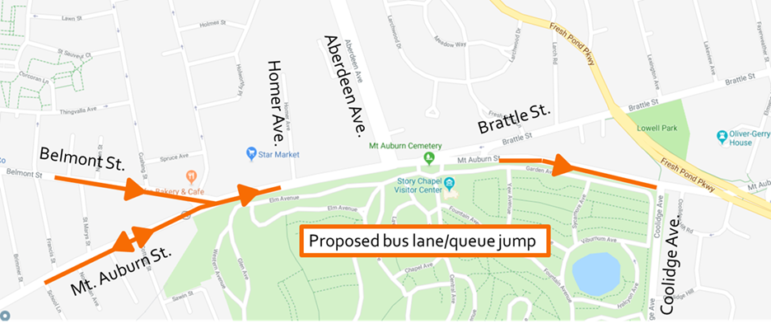
The locations of the new Bus Rapid Transit lanes.
The following information was provided by the MBTA and Town of Watertown:
Beginning the week of Oct. 15, the Town of Watertown, the City of Cambridge, the MBTA, the Mass. Department of Conservation and Recreation (DCR), the Institute for Transportation and Development Policy, and the Barr Foundation will roll out a bus priority pilot funded by a grant from the Barr Foundation to bring elements of Bus Rapid Transit (BRT) to the Mount Auburn Street Corridor, serving MBTA routes 71 and 73, as well as employee shuttles.
The project will feature painted bus and bicycle only lanes – primarily on Mount Auburn Street between Cottage Street and Coolidge Avenue in the inbound direction – as well as signage and signal changes to create faster, more reliable service for 12,000+ daily bus riders while improving traffic flow for everyone. The partners will host an official launch event with speaking program on the morning of Oct. 26 (details forthcoming).
“Watertown is pleased to work with its partners, the City of Cambridge, MBTA, and Barr Foundation to improve bus service in Watertown,” said Steve Magoon, Watertown Assistant Town Manager and Planning Director. “So many of our residents rely on the buses to get to work and around town. The priority bus lanes and queue jump lanes could really help make Watertown more accessible.”
The project will impact people utilizing different transportation modes:
MBTA 71 & 73 Buses, Mount Auburn Hospital and athenahealth Shuttles
All-day dedicated bus priority lanes on segments of Mount Auburn Street between Cottage Street in Watertown and Fresh Pond Parkway in Cambridge will allow MBTA 71 and 73 buses and shuttles to travel unimpeded by vehicular traffic. The bus priority lanes will be painted red and shared with cyclists and other shuttles and emergency vehicles. Shorter sections of bus lanes, or “queue jumps” at Belmont Street, School Street, and Walnut Street allow buses to move more quickly through intersections by jumping to the front of the line of cars stopped at a light.
Re-timed traffic signals and transit signal priority will give buses more green light time when needed. The bus priority lanes and signal improvements will cut minutes off the bus travel time in the times of the worst congestion, and more importantly, will make travel times more predictable.
Bicycling
The dedicated bus priority lane will be shared with cyclists along Mount Auburn Street. Bus drivers will be instructed to not pass bicyclists in the bus priority lane to ensure that there are no conflicts or issues. In addition, a new bicycle lane has been added on Mt. Auburn Street between Brattle Street and Belmont Street.
Driving
The right lane on segments of Mount Auburn Street going inbound or eastbound, between Cottage Street and Fresh Pond Parkway, will be off limits to cars (but available to ambulances, fire trucks, and other emergency vehicles). Cars may only be in the red lanes when a driver is making a right turn, and briefly to parallel park where parking is allowed at the curb. The boundary line and red paint becomes dashed to show drivers where to enter for a right turn. Drivers are expected to yield to buses and bikes when entering the red lane. Other cities that have tested dedicated bus priority lanes have found that they result in overall improved traffic flow for people in cars because buses no longer pull in and out of traffic.
For the “queue jump” lanes at School and Walnut Streets in Watertown to be effective, right turning drivers are now allowed to take a right turn on red to enable buses to move to the front of the traffic line and through the intersection with less delay. Parking restrictions at these intersections are in effect from 7 a.m. to 9 a.m. on the inbound side of Mount Auburn Street.
Walking
As part of implementing the new “queue jump” lanes in Watertown, drivers are allowed to turn right on red after stopping at Walnut Street and School Street. Drivers should yield to pedestrians, but pedestrians walking inbound along Mount Auburn Street should look for turning traffic before crossing School and Walnut Streets. In addition, the number of lanes pedestrians have to cross on Mount Auburn Street at Brattle Street has been reduced from four lanes to three, with a hatched-out area in the middle. Triangular yield markings (sometimes called “shark’s teeth”) have been added at this crosswalk and at the unsignalized crosswalk on Brattle Street.
The BRT features and improvements described above were recommended in a study of the Mount Auburn Street corridor completed by the DCR. This pilot, which will be done using paint and signage, will be implemented in October. It will remain in place while staff work with community members and local businesses to evaluate the pilot over the fall and winter and determine whether further adjustments are appropriate. Lessons learned from the experience will inform continued long-term planning.

These measures are long overdue and will only be the beginning of sorting out our transportation and traffic woes. But it is an initiative to be thankful for to be sure. Hopefully those who ride the 71 and 73 buses will have a bit more time to spend on other things than riding the bus.